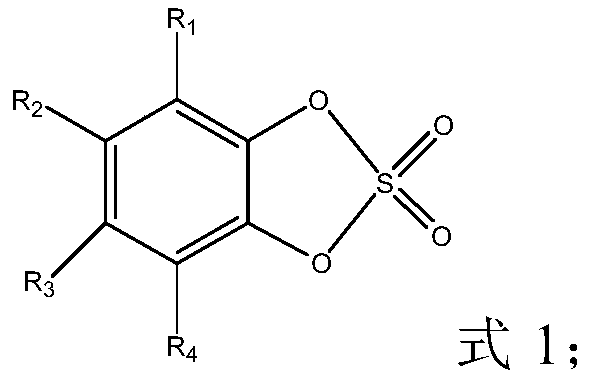Non-aqueous electrolyte and lithium-ion battery
A non-aqueous electrolyte, non-aqueous technology, used in secondary batteries, circuits, electrical components, etc., can solve the problems of low-temperature performance deterioration of lithium-ion batteries, increase the interface impedance of positive and negative electrodes, and improve lithium-ion batteries. Effect of low temperature cycle performance
- Summary
- Abstract
- Description
- Claims
- Application Information
AI Technical Summary
Problems solved by technology
Method used
Image
Examples
Embodiment 1
[0056] Lithium-ion batteries were prepared with reference to the method of Comparative Example 1, the difference being that when preparing the non-aqueous electrolyte, the additives were FEC with a mass percentage of 4%, and LiBF with a mass percentage of 0.2%. 4 , catechol cyclic sulfate with a mass percentage of 0.5%.
Embodiment 2
[0058] Lithium-ion batteries were prepared with reference to the method of Comparative Example 1, the difference being that when preparing the non-aqueous electrolyte, the additives were FEC with a mass percentage of 4%, and LiBF with a mass percentage of 0.2%. 4 , catechol cyclic sulfate with a mass percentage of 0.05%.
Embodiment 3
[0060] Lithium-ion batteries were prepared with reference to the method of Comparative Example 1, the difference being that when preparing the non-aqueous electrolyte, the additives were FEC with a mass percentage of 4%, and LiBF with a mass percentage of 0.2%. 4 , catechol cyclic sulfate with a mass percentage of 0.1%.
PUM
 Login to View More
Login to View More Abstract
Description
Claims
Application Information
 Login to View More
Login to View More - R&D
- Intellectual Property
- Life Sciences
- Materials
- Tech Scout
- Unparalleled Data Quality
- Higher Quality Content
- 60% Fewer Hallucinations
Browse by: Latest US Patents, China's latest patents, Technical Efficacy Thesaurus, Application Domain, Technology Topic, Popular Technical Reports.
© 2025 PatSnap. All rights reserved.Legal|Privacy policy|Modern Slavery Act Transparency Statement|Sitemap|About US| Contact US: help@patsnap.com



